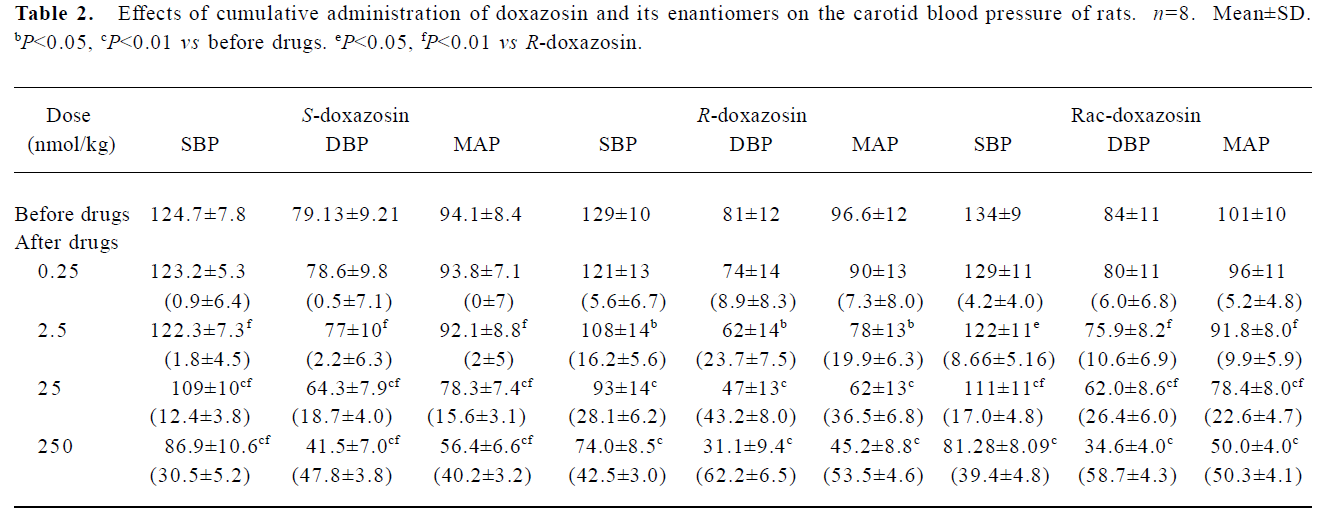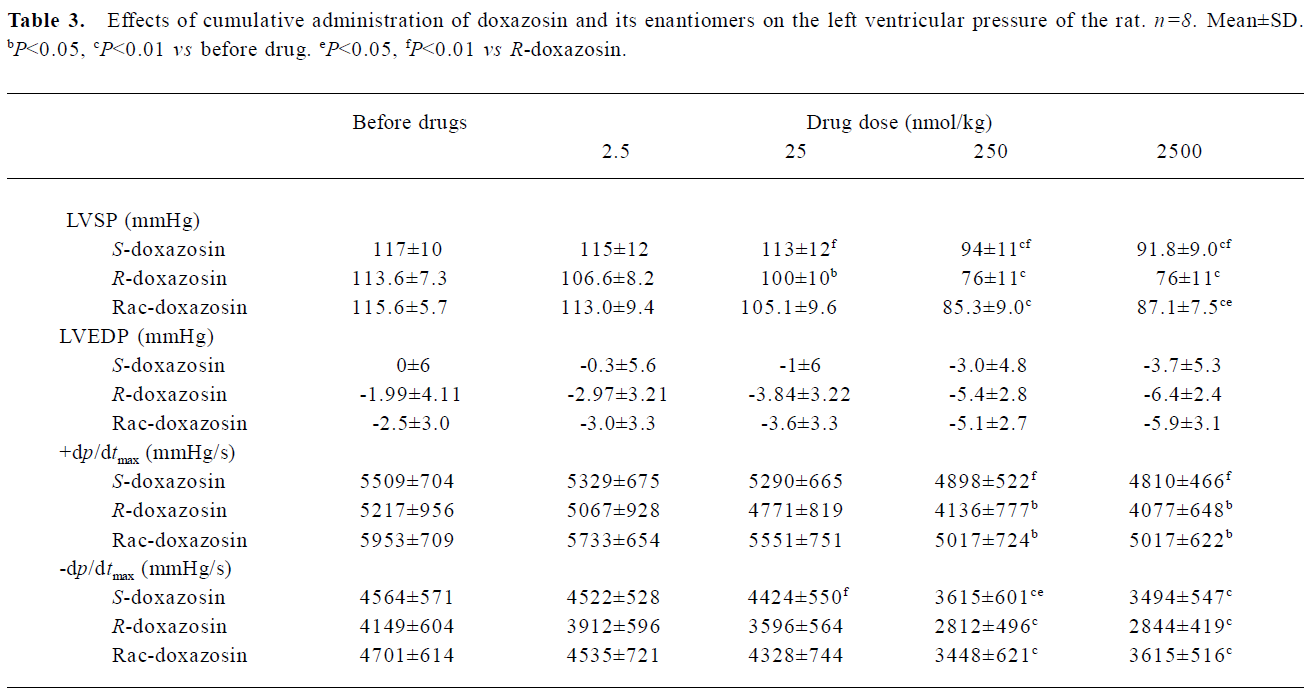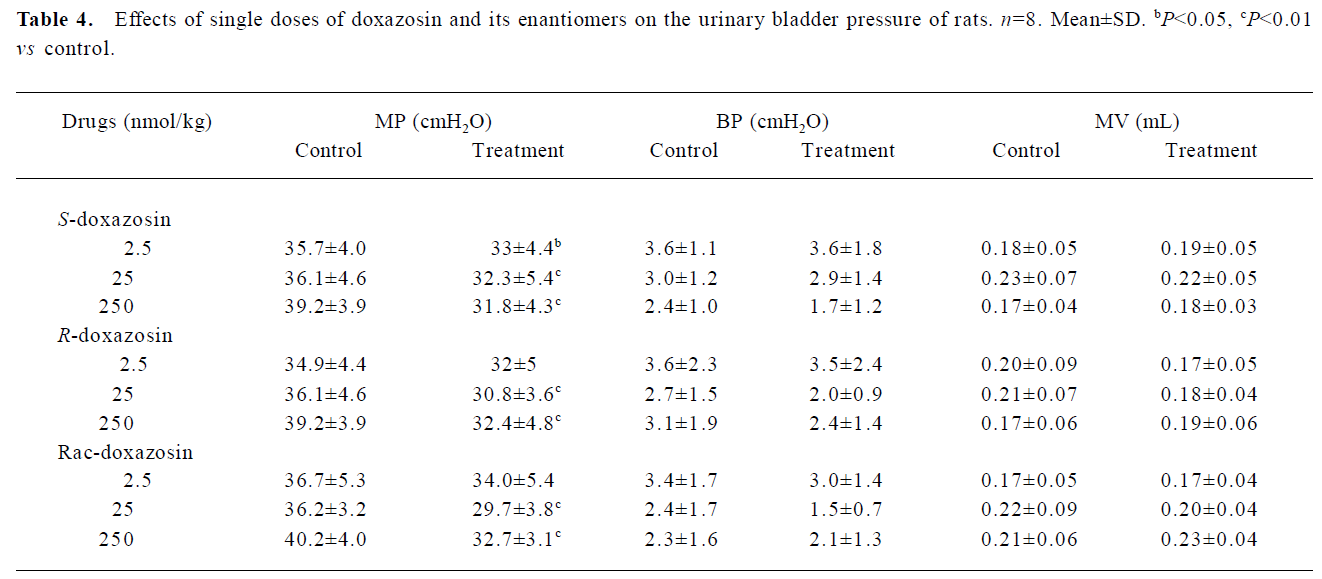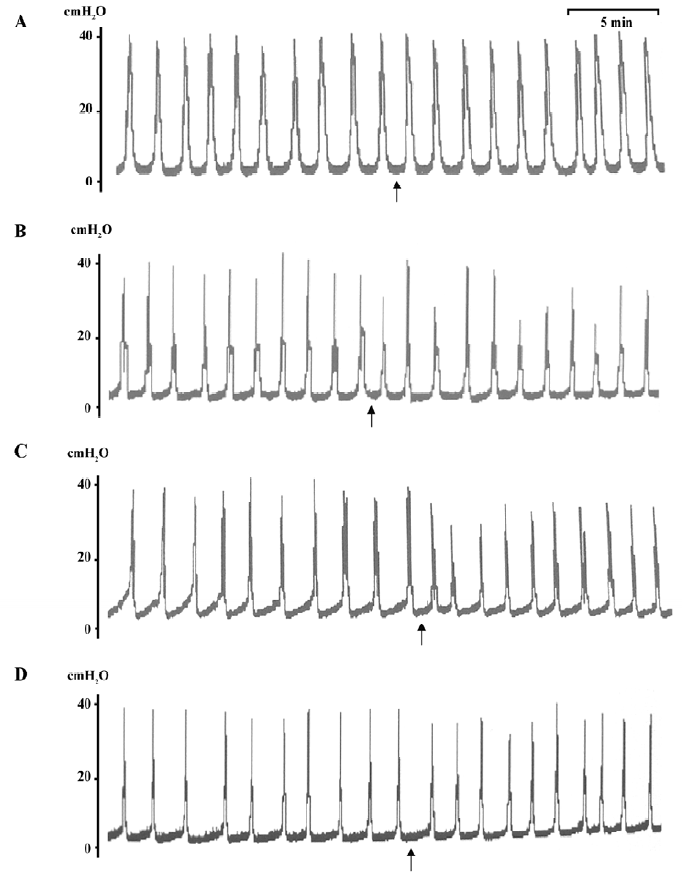Chiral selective effects of doxazosin enantiomers on blood pressure and urinary bladder pressure in anesthetized rats1
Introduction
Racemic-doxazosin (rac-doxazosin), a highly selective α1-adrenoceptor antagonist, can block the over-contraction of smooth muscle in the prostate and urethral tract and improve the urinary dynamics of benign prostatic hyperplasia (BPH) and their clinical symptoms in patients[1]. It has also been reported that adrenaline produces a contractile response, presumably mediated by the stimulation of α-adrenoceptors instead of the normal β-adrenoceptor response on the detrusor muscle obtained from the patient with BPH and outflow obstruction[2]. The pharmacological properties of doxazosin in the human prostate were characterized by Hatano et al who did not find a significant difference among the pA2 values of doxazosin and its enantiomers against phenylephrine-induced contraction via α1-adrenoceptors in the human prostate[3].
We previously reported that rac-doxazosin reduced urethral pressure increased by the hypogastric nerve stimulation in an anesthetized cat[4]. We also found that the efficacy of S-doxazosin against the noradrenaline-induced contraction in the isolated rabbit thoracic aorta and carotid artery was much lower than that of R-doxazosin and rac-doxazosin[5]. These results might imply that S-doxazosin is an agent preferentially acting on the lower urinary tract tissues with minor cardiovascular side effects. In order to identify the chiral selective effects of doxazosin enantiomers between the cardiovascular system and the urinary system, we attempted to observe the effects of rac-doxazosin, R-doxazosin and S-doxazosin on the blood pressure, left ventricular pressure of the heart and the urinary bladder pressure in anesthetized rats.
Materials and methods
Rats Male Wistar rats (200–300 g) were obtained from the Experimental Animal Center of Hebei Medical University (Certificate N
Chemicals Rac-doxazosin methane sulphonate, R-doxazosin hydrochloride and S-doxazosin hydrochloride are white crystalline powder, synthesized by and obtained from the Center for Drug Research and Development, North China Pharmaceutical Corporation. All chemicals were dissolved in distilled water.
Arterial blood pressure and heart rate Rats were anesthetized with urethane (1 g/kg sc and 1 g/kg ip), and a catheter was inserted into the trachea to allow drainage of bronchial secretion and to facilitate breathing. Polyethylene catheters were inserted into the right femoral vein for drug administration and into the left common carotid artery for blood pressure measurement, respectively. Blood pressure was monitored via the arterial catheter connected to a MLT0380/D Reusable BP Transducer (PowerLab, ADInstruments, Castle Hill, Australia), and displayed on PowerLab/8sp (AD-Instruments, Castle Hill, Australia) through an IBM computer running the PowerLab Chart 4.0 software (ADInstru-ments, Castle Hill, Australia). The heart rate (HR) was monitored via an electrocardiogram recorded on PowerLab/8sp. After an equilibration period of 30 min, doxazosin and its enantiomers were injected into the femoral vein. Changes produced by rac-doxazosin, R-doxazosin and S-doxazosin in systolic blood pressure (SBP), diastolic blood pressure (DBP), mean arterial blood pressure (MAP) and HR were recorded. Each agent was administered at 0.25, 2.5, 25, and 250 nmol/kg, respectively. Forty rats were randomly divided into 2 groups (S-doxazosin group and R-doxazosin group) and only 1 dose of S-doxazosin or R-doxazosin was administered (0.5 mL/kg, iv) to each animal; an additional 5 rats were given normal saline as the control group. The purpose of a single administration of doxazosin enantiomers was to observe the time-response course of each dose of S-doxazosin and R-doxazosin, and we found that the responses to doxazosin enantiomers at 2.5 nmol/kg reached a peak value about 20 min after administration; those of higher doses reached a peak value within 5 min after administration. The other 24 rats were randomly divided into 3 groups (S-doxazosin group, R-doxazosin group and rac-doxazosin group) and 1 agent at 4 doses (0.25, 2.5, 25, and 250 nmol/kg) was administered cumulatively to each rat. An additional 8 rats were given normal saline as the control group.
Left ventricular pressure Rats were anesthetized with urethane (2 g/kg, 1 g/kg sc and 1 g/kg ip) and a catheter was intubated into the trachea to facilitate breathing. A polyethylene catheter (OD 1.2 mm, ID 1.0 mm) was filled by heparin (12500 U/500 mL), and its outer wall was lubricated with paraffin liquid. The pulse pressure dropped suddenly as soon as the catheter was inserted into the left ventricle through the right carotid artery. At the end of experiment, the aortic valve was examined[6]. After the left ventricular pressure was recorded for 30 min, rac-doxazosin, R-doxazosin or S-doxazosin was injected into the femoral vein, and the left ventricular systolic pressure (LVSP), left ventricular end-diastolic pressure (LVEDP), ±dp/dtmax and HR were recorded on PowerLab/8sp. Twenty-four rats were randomly divided into 3 groups (S-doxazosin group, R-doxazosin group and rac-doxazosin group), and 1 agent at 4 doses (2.5, 25, 250, and 2500 nmol/kg) was administered cumulatively to each rat. We observed and compared the effects of S-doxazosin, R-doxazosin and rac-doxazosin using a cumulative administration design in the experiments of blood pressure and ventricular pressure. The second dose (25 nmol/kg) was given 20 min after the first dose (2.5 nmol/kg), and other higher doses were given 5 min after the front administrations. An additional 8 rats were given normal saline as the control group.
Urinary bladder pressure The rats were anesthetized with urethane (1.2 g/kg sc). The bladder was exposed through a suprapubic longitudinal incision and a small hole was made at the dome of the bladder[7,8] in order to intubate a double lumen catheter into the bladder. Then the double lumen catheter was fixed with silk ligation. An inner catheter (OD 0.7 mm) of the double lumen catheter was connected to an infusion pump for perfusion with Tyrode’s solution without sugar at 10 mL/h, and intravesical pressure was continuously recorded via the outer catheter (OD 1.4 mm) on PowerLab/8sp. To eliminate the influence by the pump perfusion on the intravesical pressure, the top of inner catheter was 2 mm longer than that of outer catheter of the double lumen catheter. After obtaining control cystometrograms, we injected drugs through the femoral vein, then the micturition pressure (MP; maximal bladder pressure during micturition), basal pressure (BP; the lowest bladder pressure during filling), intercontraction interval (ICI; the interval between voids) and micturition volume (MV; the volume of expelled urine) were recorded. Seventy-two rats were divided into 3 groups (S-doxazosin group, R-doxazosin group and rac-doxazosin group) randomly, and 3 doses (2.5, 25, and 250 nmol/kg) of each agent were given. Only 1 dose of an agent was administered (0.5 mL/kg) to 1 animal. An additional 8 rats were given normal saline as the control group. After an equilibration period of 15 min, 10 continuous micturition cycles were recorded before drug administration, and their mean values were calculated as the control. Ten continuous micturition cycles were then immediately recorded after administration and their mean values were calculated as drug effects.
Statistical analysis Data were expressed as mean±SD, and ED30 values (producing a 30% decrease in MAP) were calculated with weighted probit analysis (Bliss and Finney, using NDST version 4.2, 1996, Sun RY, et al, editors). One-way ANOVA was used to evaluate any differences among the concentration-dependent responses. Comparison of a pair of responses before and after treatment was analysed by paired t-test in the same preparation. Comparisons between the 2 groups were made by unpaired t-test, and comparisons among 3 or more groups were made by Dunnett’s multiple comparisons test (using GraphPat InStat V2.05a, San Diego, CA, USA). P values less than 0.05 were considered statistically significant.
Results
Influence of single dose of doxazosin enantiomers on the carotid blood pressure and HR in anesthetized rats SBP, DBP and MAP in the control animals did not change significantly during the period 60 min after giving normal saline (P>0.05, n=5; data not shown). Doxazosin enantiomers decreased the carotid blood pressure in a dose-dependent manner. R-doxazosin at 0.25, 2.5, 25, and 250 nmol/kg decreased the SBP, DBP and MAP more potently than S-doxazosin (P<0.01; Tab1e 1; Figure 1). R-doxazosin at 250 nmol/kg decreased SBP by 50.2%, DBP by 60.6% and MAP by 56.6%, while S-doxazosin at the same dose decreased SBP by 31.8%, DBP by 41.1% and MAP by 37.3%. R-doxazosin at 25 and 250 nmol/kg and S-doxazosin at 250 nmol/kg decreased the HR slightly (by 7.8%, 11.0% and 7.3%), but significantly (P<0.05 and 0.01, n=5).

Full table

Influence of cumulative administration of doxazosin and its enantiomers on the carotid blood pressure and HR in anesthetized rats SBP, DBP and MAP in the control animals did not change significantly at 30 min, 60 min, 90 min, and 120 min after giving normal saline 4 times (P>0.05, n=8; data not shown). Cumulative administration of doxazosin enantiomers at 0.25, 2.5, 25, and 250 nmol/kg produced similar effects on the SBP, DBP and MAP like single dose administration (Table 2). The ED30 values (producing a 30% decrease in MAP) of R-doxazosin, rac-doxazosin and S-doxazosin were 15.6±9.4, 45.9±20.6 and 128.8±35.7 (n=8), respectively and their ratio was 1:3:8. R-doxazosin at 250 nmol/kg, but not S-doxazosin and rac-doxazosin, decreased the HR slightly (by 10.9%), but significantly (P<0.05, n=8).

Full table
Influence of cumulative administration of doxazosin and its enantiomers on the left ventricular pressure in anesthetized rats LVSP, LVEDP and ±dp/dtmax in the control animals did not change significantly at 30 min, 60 min, 90 min, and 120 min after giving normal saline 4 times (P>0.05, n=8; data not shown). Rac-doxazosin and its enantiomers at 250 and 2500 nmol/kg decreased the LVSP (P<0.01) and -dp/dtmax (P<0.01), and the inhibitory effects by S-doxazosin were significantly weaker than those by R-doxazosin (Table 3). R-doxazosin and rac-doxazosin at 250 and 2500 nmol/kg significantly decreased the +dp/dtmax, but the 3 agents did not significantly change the LVEDP in anesthetized rats (Table 3).

Full table
Influence of a single dose of doxazosin and its enantiomers on the urinary bladder pressure in anesthetized rats MP, BP, ICI, and MV in the control animals did not change significantly during the period of 60 min after giving normal saline (P>0.05, n=8; data not shown). S-doxazosin at 2.5, 25, and 250 nmol/kg significantly decreased the MP; R-doxazosin and rac-doxazosin at 25 and 250 nmol/kg decreased the MP (Table 4). There was no significant difference among the 3 agents for their inhibitory effects on the MP (P>0.05, n=8). The 3 agents did not significantly affect the values of BP, ICI, and MV (P>0.05, n=8, Figure 2).

Full table

Discussion
α1-adrenoceptors mediate some of the main actions of the natural catecholamines, such as epinephrine and nor-epinephrine, and have a crucial role in the regulation of arterial blood pressure[9]. Their antagonists can relax the arteriole and vein so as to decrease the standing and lying blood pressure. There are functional α1A- and α1D-adrenoceptor subtypes in response to the vasoconstriction of the rat common carotid arteries, but no α1B-adrenoceptor subtype[10]. The analysis of mutant mice has provided some insight into the physiological role of each α1-adrenoceptor subtype in the regulation of blood pressure. α1A-adrenoceptors play an extremely significant role in maintaining basal blood pressure, whereas α1B-adrenoceptors are important in the pressure response to catecholamines and α1D-adrenoceptors play a role in both physiological responses[9].
Doxazosin is an α1-adrenoceptor antagonist with pharmacological properties similar to those of prazosin. Recently, we found that the pA2 values of S-doxazosin, concerning the vasoconstrictive responses to noradrenaline in the rabbit isolated thoracic aorta and common carotid artery, were significantly lower than those of R-doxazosin and rac-doxazosin[5]. The present study further showed that doxazosin and its enantiomers administered intravenously obviously decreased the carotid blood pressure, but the inhibitory effects by the 3 agents on blood pressure were significantly different and their potency order was R-doxazosin>rac-doxazosin>S-doxazosin. S-doxazosin decreased the HR slightly only at the highest dose, and its action on the HR was significantly weaker than R-doxazosin.
In adult rat tissues, the α1A-adrenoceptor protein is most marked in the brain, intermediate in the heart, aorta, liver, vas deferens, and minimal in the kidney and prostate[11]. It has been confirmed that the 3 subtypes of α1-adrenoceptors are all expressed in the heart, but their expression extent in mRNA and protein levels is different. In this study, doxazosin and its enantiomers administered cumulatively to the anesthetized rats decreased the LVSP and -dp/dtmax significantly at 250 and 2500 nmol/kg, and the inhibitory effects by S-doxazosin were significantly weaker than those by R-doxazosin. At 250 and 2500 nmol/kg, R-doxazosin and rac-doxazosin, but not S-doxazosin, significantly decreased the +dp/dtmax. Results obtained from the above studies in the carotid blood pressure and left ventricular pressure indicate that S-doxazosin has a weak inhibitory effect on the cardiovascular system in comparison with R-doxazosin and rac-doxazosin. It is well known that blood pressure is regulated primarily by cardiac output, total peripheral resistance and blood volume, and it is also controlled by central and peripheral sympathetic activity. Further experiments should be designed to investigate the effects of doxazosin enantiomers on the sympathetic nerve activity, blood vessel resistance and isolated heart tissues to clarify the different mechanism between S-doxazosin and R-doxazosin.
BPH is a common cause of urinary flow obstruction in ageing men and may lead to lower urinary tract symptoms. At present, α1-adrenoceptor antagonists are usually considered as the first-line therapy for BPH patients[12]. Therefore, we further investigated the influence of doxazosin and its enantiomers on the urinary bladder pressure in anesthetized rats.
The affinities of doxazosin and its enantiomers for the α1-adrenoceptor subtypes have been determined in radioligand-binding studies using the membrane preparations isolated from rat fibroblast expressing the human α1A-, α1B- and α1D-adrenoceptor subtypes, and rac-doxazosin, R-doxazosin and S-doxazosin are potent antagonists with balanced activity across all three cloned human α1-adreno-ceptor subtypes[3]. Ishizuka et al[13] reported that in conscious rats, intrathecal administration of rac-doxazosin at 60 mg/kg decreased the micturition pressure of the urinary bladder by 13 cmH2O when the bladder was perfused with saline constantly by means of a pump, and its effect on micturition pressure was much more pronounced in the animal with post-obstruction bladder hypertrophy induced by partial ligature of the urethra. They also indicated that doxazosin enantiomers administered intrathecally produced qualitatively similar effects on micturition pressure to rac-doxazosin[13]. In the present study, we demonstrated that in the anesthetized rats, intravenous administration of S-doxazosin at 2.5, 25, and 250 nmol/kg significantly decreased the urinary bladder MP, and there was no significant difference among rac-doxazosin, S-doxazosin and R-doxazosin for their inhibitory effects on MP of the urinary bladder. The 3 agents administered intravenously did not significantly affect the other cystometric parameters recorded.
Although Hatano et al reported that R-doxazosin and S-doxazosin were potent antagonists with balanced activity across all 3 cloned human α1-adrenoceptor subtypes, we were not able to confirm the similar results in the experiments of the carotid blood pressure and left ventricular pressure of the heart in the anesthetized rats when the drugs were given intravenously, except for the experiment of urinary bladder micturition. The possible reasons for the conflicting results are not clear, but some underlying mechanisms can be considered. First, the pharmacological profile of the wild-type of α1-adrenoceptor subtypes in tissues or in vivo might be different from that of cloned type of α1-adrenoceptor subtypes in cultured cells. Second, functions of the cardiovascular and urinary system are regulated by many factors including α1-adrenoceptors; some unknown effects might be involved in doxazosin enantiomers. It has been well established that sympathetic and parasympathetic nuclei in the lumbosacral cord receive inputs from noradrenergic neurons in the brainstem, and these pathways have been implicated in the supraspinal control of micturition[14]. Antagonism at the α1-adrenoceptors on the detrusor muscle or at prejunc-tional α1-adrenoceptors facilitating acetylcholine release in the bladder[15], would produce decreased MP. Recently Szell et al[16] reported that cholinergic nerve terminals α1A-adrenoceptors mediated prejunctional facilitation, whereas postjunctional α1B/α1D-adrenoceptors mediated smooth muscle contraction of the rat urinary bladder. Further experiments should be done with the isolated detrusor muscle, prostate smooth muscle and urethral smooth muscle to observe the precise effects of doxazosin enantiomers.
In summary, the current results suggest that in anesthetized rats, S-doxazosin administered intravenously at the used dosages reduces the carotid blood pressure and left ventricular pressure of the heart less than R-doxazosin and rac-doxazosin, but its effect on the vesical micturition pressure is similar to R-doxazosin and rac-doxazosin, indicating that S-doxazosin has chiral selectivity between cardiovascular system and urinary system in anesthetized rats.
References
- Lepor H, Baumann M, Shapiro E. Binding and functional properties of doxazosin in the human prostate adenoma and canine brain. Prostate 1990;16:29-38.
- Perlberg S, Caine M. Adrenergic response of bladder muscle in prostatic obstruction. Its relation to detrusor instability. Urology 1982;20:524-7.
- Hatano A, Tang R, Walden PD, Lepor H. The α-adrenoceptor antagonist properties of the enantiomers of doxazosin in human prostate. Eur J Pharmacol 1996;313:135-43.
- Yang ZH, Ren LM, Wu ZJ, Fu SX, Li YS. Selective effects of alfuzosin and doxazosin with intraduodenal administration on urethral pressure of cats. Acta Pharmacol Sin 1999;20:431-4.
- Niu CQ, Zhao D, Jia XM, Ren LM. α1-Adrenoceptor antagonist profile of doxazosin and its enantiomers in isolated rabbit blood vessels. Chin J Pharmacol Toxicol 2003;17:354-9.
- Sun L, Rao MR, Liu PQ. Effects of praeruptorin C on cardiac dysfunction, myocardial compliance and collagen content in reno-vascular hypertensive rats. Acta Pharm Sin 1997;32:578-82.
- Myers RA, Plym MJ, Signor LJ, Lodge NJ. 1-(2-pyrimidinyl)-piperazine, a buspirone metabolite, modulates bladder function in the anesthetized rat. Neurourol Urodyn 2004;23:709-15.
- Angelico P, Velasco C, Guarneri L, Sironi G, Leonardi A, Testa R. Urodynamic effects of oxybutynin and tolterodine in conscious and anesthetized rats under different cystometrographic conditions. BMC Pharmacol 2005;5:14.
- Tanoue A, Koshimizu TA, Shibata K, Nasa Y, Takeo S, Tsujimoto G. Insights into α1 adrenoceptor function in health and disease from transgenic animal studies. Trends Endocrinol Metab 2003;14:107-13.
- Chiba S, Tsukada M. Existence of functional α1A- and α1D- but no α1B-adrenoceptor subtypes in rat common carotid arteries. Jpn J Pharmacol 2002;88:146-50.
- Shen H, Peri KG, Deng XF, Chemtob S, Varma DR. Distribution of alpha1-adrenoceptor subtype proteins in different tissues of neonatal and adult rats. Can J Physiol Pharmacol 2000;78:237-43.
- Oades GM, Eaton JD, Kirby RS. The clinical role of alpha-blockers in the treatment of benign prostatic hyperplasia. Curr Urol Rep 2000;1:97-102.
- Ishizuka O, Persson K, Mattiasson A, Naylor A, Wyllie M, Andersson K. Micturition in conscious rats with and without bladder outlet obstruction: role of spinal alpha1-adrenoceptors. Br J Pharmacol 1996;117:962-6.
- de Groat WC. Anatomy of the central neural pathways controlling the lower urinary tract. Eur Urol 1998;34 suppl 1:2-5.
- Somogyi GT, Tanowitz M, de Groat WC. Prejunctional facilitatory alpha1-adrenoceptors in the rat urinary bladder. Br J Pharma-col 1995;114:1710-6.
- Szell EA, Yamamoto T, de Groat WC, Somogyi GT. Smooth muscle and parasympathetic nerve terminals in the rat urinary bladder have different subtypes of α1 adrenoceptors. Br J Pharmacol 2000;130:1685-91.
